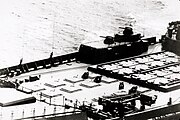
P-700 Granit
The P-700 Granit (Russian: П-700 "Гранит"; English: granite) is a Soviet and Russian naval anti-ship cruise missile. Its GRAU designation is 3M45, its NATO reporting name SS-N-19 Shipwreck. It comes in ASCM and SLCM variants.
Design and building[]
The P-700 was designed in the 1970s to replace the P-70 Ametist and P-120 Malakhit, both effective missiles but with too short a range in the face of improving weapons of U.S. Navy carrier battle groups. The missile was partially derived from the P-500 Bazalt.
Built by Chelomei/NPO Mashinostroenia, the bulging 10m missile has swept-back wings and tail, weighs around 7,000 kilograms and can be fitted with either a 750 kg HE warhead, a FAE warhead, or a 500 kt nuclear warhead. A stubby cylindrical solid-fuel rocket is fitted to the rear for launch; this booster stage is released when the missile enters sustained flight using its KR-93 turbojet engine. The P-700 has a distinctive annular air intake in the nose. Maximum speed is believed to be between Mach 1.6 and more than Mach 2.5.[1] Range is estimated at 500 to 550–625 km.[1] The guidance system is mixed-mode, with inertial, active terminal guidance with radar and also anti-radar homing. Mid-course correction is probable.
The missile, when fired in a swarm (group of 4–8) has a unique guidance mode. One of the weapons climbs to a higher altitude and designates targets while the others attack. The missile responsible for target designation climbs in short pop-ups, so as to be harder to intercept. The missiles are linked by data connections, forming a network. If the designating missile is destroyed the next missile will rise to assume its purpose. Missiles are able to differentiate targets, detect groups and prioritize targets automatically using information gathered during flight and types of ships and battle formations pre-programmed in an onboard computer. They will attack targets in order of priority, highest to lowest: after destroying the first target, any remaining missiles will attack the next prioritized target.[2][3] The missile has a means of countering the attacking anti-missiles. Also, onboard computer has data to counter the enemy's electronic warfare and tactics of evasion from the fire of air defense.[2]
The P-700 was derived from the P-500 Bazalt missile with a turbojet.[4] The P-700 was in turn developed into the P-800 Oniks, which uses ramjet propulsion, and the BrahMos missile, a joint Indian/Russian modernization of the P-800.
Deployment[]

SS-N-19 launchers on the Kirov class cruiser Frunze.
Initial deployment was aboard the cruiser Kirov (now the Admiral Ushakov) in 1980 and the missile entered service in 19.07.1983.[5] It is currently in service: 1) with the Russian Northern Fleet on the Kirov-class battlecruisers Admiral Nakhimov and Pyotr Velikyi and the aviation cruiser Kuznetsov 2) with the Russian Northern and Pacific fleets as part of the Oscar class large guided missile submarines armoury (the Kursk carried 24 missiles). However, the size of the missile limits the platforms on which it can operate and be launched from. Produced in 1974–1994.[6]
Former operators[]
Current operators[]
Specifications[]
- Name: P-700 (SS-N-19)
- Type: Long-range anti-ship cruise missile
- Developed: Russia
- Weight: 7,000 kg (15,000 lb)
- Length: 10 m (33 ft)
- Diameter: 0.85 m (33 in)
- Warhead: 750 kg (1,650 lb) HE (unknown composition, probably RDX or similar) or 500 kt fission-fusion thermonuclear
- Guidance: Inertial, active radar with home-on-jam, and Legenda satellite targeting system (believed to be nonfunctional after the fall of the USSR)
- G limit: 18
- Maximum Mach number: 1.6 – more than 2.5
- Range: 500 km (310 mi)[7]
- Platforms: Kirov CGN, Kuznetsov CVG, Oscar SSGN
See also[]
References[]
- ↑ P-700 3M-45 Granat SS-N-19 Shipwreck
- ↑ [7.0] Soviet-Russian Naval Cruise Missiles / Chinese Cruise Missiles
- ↑ ГРАНИТ
- ↑ http://pa-strela.com/index.php/en/products/military-goods/bazalt
- ↑ http://www.npomash.ru/press/ru/podrobnee190713.htm?l=0
- ↑ http://www.testpilot.ru/orenburg/s_list.htm
- ↑ http://www.pa-strela.com/index.php/en/products/military-goods/granit
- Jane's Underwater Weapon Systems 2006–2007
External links[]
- www.dtig.org Russian/Sovjet Sea-based Anti-Ship Missiles (pdf)
The original article can be found at P-700 Granit and the edit history here.